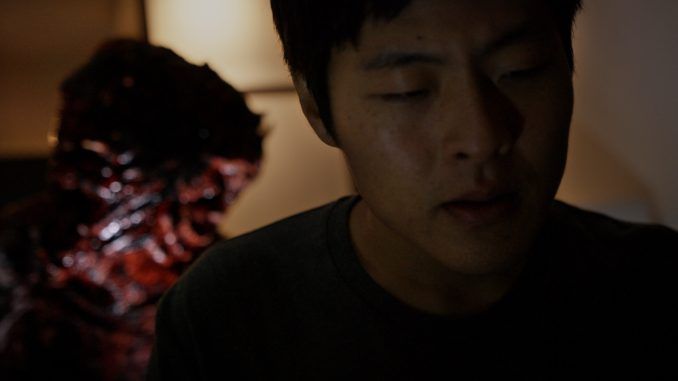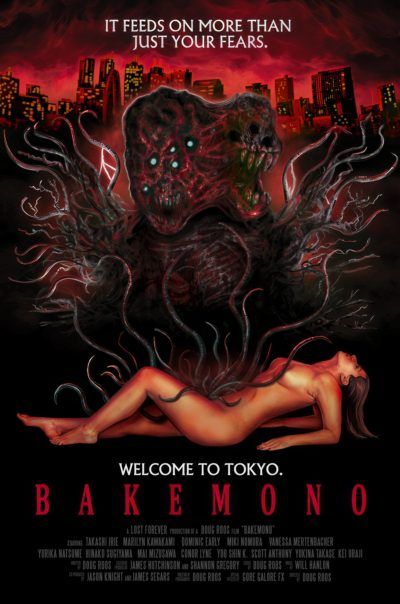
Rating: B-
Dir: Doug Roos
Star: Takashi Irie, Marilyn Kawakami, Dominic Early, Miki Nomura
I don’t think we’ll be renting an apartment in Tokyo any time soon, between the deficient lighting and the creepy caretakers. Oh, and the demonic activity. That may be the abiding takeaway from this grimy, tenticular little effort by Roos, an American living in Japan. It acts as an energetic counterpoint to the usual depiction of the city as a neon-drenched metropolis, instead largely taking place in a shadowy gloom which is oppressive to the point of overwhelming. Things unfold largely in a low-rent apartment building, inhabited by a series of transients, most of whom are there for a short time, rather than a good time. [Basically an AirBNB] For instance, Chris (Early) is in Tokyo on a teaching assignment, which has taken him away from his wife and daughter.
It’s a dingy set of cramped accommodations, the kind of place in which nobody would really spend time out of choice. In charge is Mitsuo (Irie), who seems to be weird from the get-go. Such concerns prove amply justified, because it turns out, he is a big fan of the occult, and summoned a demon into the apartment building. Quite why, remains largely opaque. However, it is not exactly helping his host rating, both by attacking residents directly, and by triggering them to act out violently against each other. It’s a monster in every sense: the director said he was inspired by The Thing, and this critter would seem quite at home in the Antarctic. Or Innsmouth, for there’s brooding, Lovecraftian menace here to spare.
 I do wish we could see a bit more of what was going on. One of the most effective elements of The Thing, was John Carpenter’s refusal to hide the monster. I love how it is right there in front of you, under the harsh fluorescent light, almost mocking the “leave things to the viewer’s imagination” theory. Here, you rarely get to experience the monster in its glorious, well-lit entirety. Instead, it feels as if every resident’s primary focus is less survival, than saving money on their electricity bill. This is a pity, since what we see looks good, and demonstrates conclusively that low-budget practical FX are always going to be superior to low-budget CGI.
I do wish we could see a bit more of what was going on. One of the most effective elements of The Thing, was John Carpenter’s refusal to hide the monster. I love how it is right there in front of you, under the harsh fluorescent light, almost mocking the “leave things to the viewer’s imagination” theory. Here, you rarely get to experience the monster in its glorious, well-lit entirety. Instead, it feels as if every resident’s primary focus is less survival, than saving money on their electricity bill. This is a pity, since what we see looks good, and demonstrates conclusively that low-budget practical FX are always going to be superior to low-budget CGI.
The performances are surprisingly strong. I say “surprisingly” because I am painfully aware how low-budget cinema frequently involves using the actors you can get, rather than the ones you need. The results tend. for example, to have people as gangsters who are patently not gangsters. Here though, while there are varying degrees of experience, most are residents of Tokyo, playing… residents of Tokyo. Not much of a stretch – yet as ever, it’s all about knowing how to work within your resource limitations. The one doing most “acting” is likely Irie, and his performance is impressive, consistently unsettling from almost the first time we see him.
That said, there’s perhaps too much going on. It follows a slew of inhabitants, and it’s unclear whether all their threads are going on concurrently or consecutively. Less, such as telling Chris’s story in greater detail, might have been more, and Roos’s decision to tell things out of order, didn’t feel like it added much – except some initial confusion! However, it remains a fascinating, likely unique viewing experience, and a fine example of doing a lot with a little. It certainly operates as a very nice contrast to Godzilla: Minus One. In Tokyo, monsters come in all shapes and sizes…
The film premiered at the San Francisco Another Hole in the Head Film Festival on December 9th, and will then go on the festival circuit. He’s still raising money for it, if you feel like chipping in.
